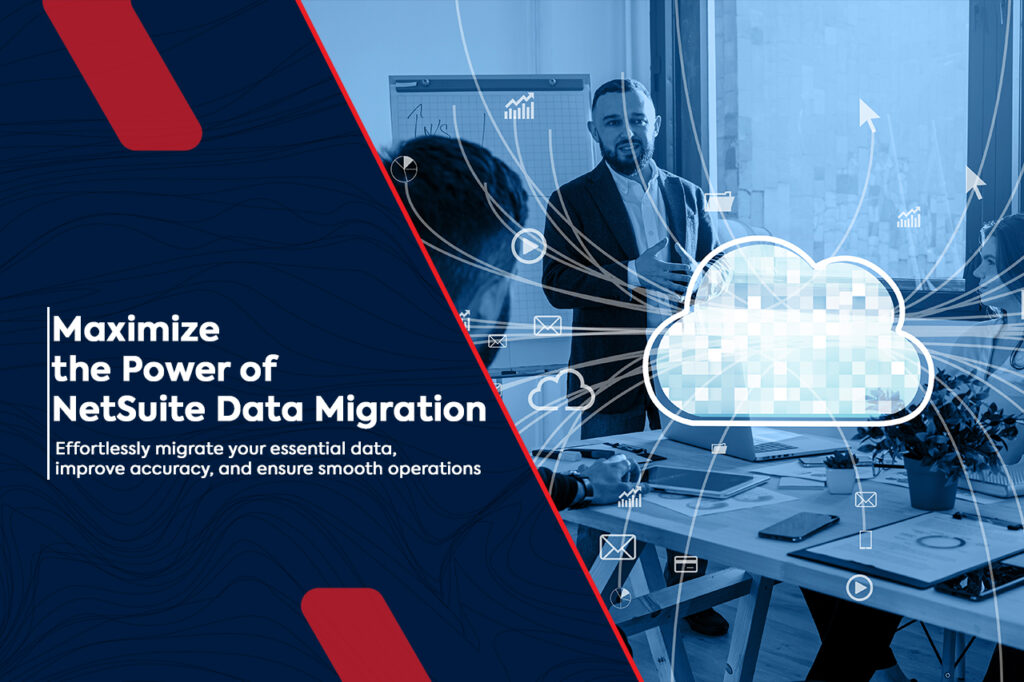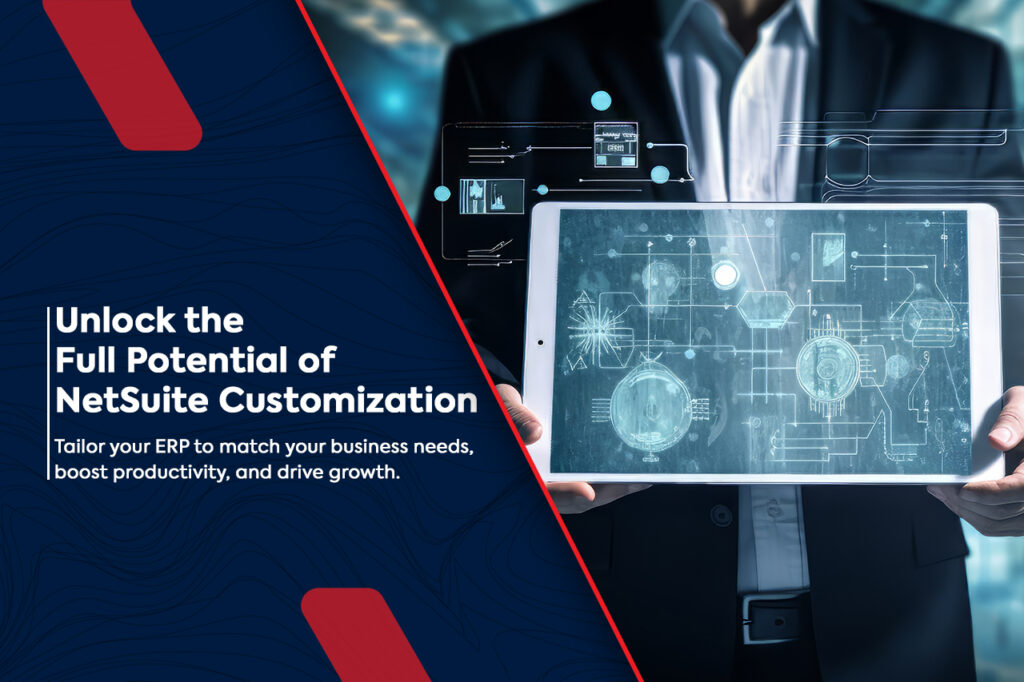Streamlining Your Business with NetSuite Data Migration

Streamlining Your Business with NetSuite Data Migration Effective data migration and management are essential for success in the fast-paced commercial world of today. Transitioning to NetSuite, a leading ERP system, involves moving data from your current systems to NetSuite. This process, known as data migration, ensures that your business operations continue seamlessly during the transition. What is NetSuite Data Migration? NetSuite data migration refers to the process of transferring your data to the NetSuite ERP platform. Whether you are upgrading from an older ERP system or consolidating data from various sources, this migration aims to move essential business information, such as financial records, customer details, and transaction histories, accurately into NetSuite. Why is Data Migration Important for NetSuite? Ensures Seamless Operations A well-executed NetSuite data migration ensures your business processes remain uninterrupted. Accurate and complete data migration consolidates your information into one unified platform, making daily operations more efficient. This smooth transition helps prevent operational disruptions and enhances overall productivity. Enhances Data Accuracy: Migrating to NetSuite offers an opportunity to clean and standardize your data. Legacy systems often contain inconsistent data due to different formats, errors, or missing information. NetSuite migration helps rectify these issues, ensuring that your records are accurate and consistent. This improvement in data quality supports better decision-making and operational efficiency. Enables Better Reporting and Analytics: Once data is moved to NetSuite, you can employ sophisticated reporting and analytics capabilities.With the powerful capabilities in NetSuite, you can extract specific insights from your data and provide your company a competitive advantage.A successful migration lays the groundwork for leveraging these capabilities effectively. Key Steps in NetSuite Data Migration Successful data migration to NetSuite involves several key steps: Data Assessment and Planning: Assessing the data that needs to be moved should be the first step. Determine the kind, location, and quantity of the data. You can better organize the relocation process if you know what is important for your company. Develop a clear plan that includes setting timelines, defining goals, and identifying the necessary tools and resources. Data Extraction: The next step is to extract data from your existing systems, databases, or spreadsheets. Perform this extraction carefully to avoid data loss or corruption. Accurate extraction sets the stage for a successful migration. Data Cleansing and Transformation: After extraction, cleanse the data by removing duplicates, irrelevant information, and errors. This step ensures that only high-quality data is transferred to NetSuite. During the transformation phase, adjust the data format to align with NetSuite’s requirements. This may include reformatting dates, consolidating categories, or converting currencies. Data Validation: Before finalizing the migration, validate the data to confirm its accuracy and completeness. This step involves checking for errors or inconsistencies that could impact the data once imported into NetSuite. Validation helps catch potential issues early, ensuring a smoother migration. Data Loading: Load the cleansed and validated data into NetSuite. Use appropriate tools or scripts to import the data into the system. Ensure that all critical information is correctly entered and available within NetSuite. Post-Migration Testing: After loading the data, conduct thorough testing to verify that everything has been transferred correctly. Check that all records are present, workflows function as expected, and there are no discrepancies. Post-migration testing helps identify and resolve issues before the system goes live. Common Challenges in NetSuite Data Migration Data Quality Issues: Dealing with poor-quality data is a common challenge. Inconsistent or incomplete data can lead to errors or incorrect information being loaded into NetSuite. To address this, focus on thorough data cleansing to ensure a smooth migration. Complex Data Structures: Migrating complex data structures can be challenging. Businesses dealing with large volumes of data or intricate structures may require additional customization or advanced data mapping. This complexity can add time and difficulty to the migration process. Integration with Legacy Systems: Migrating from outdated or incompatible legacy systems can pose difficulties. Legacy systems might not integrate smoothly with NetSuite. This complexity can add time and difficulty to the migration process. Best Practices for Successful NetSuite Data Migration Develop a Clear Migration Plan: A clear and detailed migration plan is essential. Define your goals, set realistic timelines, and allocate resources effectively. A well-documented plan helps manage risks and keeps the migration process on track. Cleanse Your Data: Ensure your data is accurate, consistent, and error-free before migration. By cleansing your data beforehand, you reduce the likelihood of issues during the migration process and enhance the quality of the data in NetSuite. Test Before Going Live: Perform comprehensive testing before the system goes live. Testing helps identify issues with data integrity, workflows, or integrations, allowing you to address them proactively. This step is crucial for a successful transition. Collaborate with Experts: If your team lacks experience in data migration, consider working with NetSuite experts or consultants. They can provide valuable guidance and ensure that the migration process is completed successfully. Conclusion Migrating to NetSuite offers numerous benefits, including enhanced data accuracy, improved reporting, and streamlined operations. However, the process can be complex and requires careful planning, data cleansing, and validation. By following best practices and addressing common challenges, businesses can achieve a smooth migration and fully leverage NetSuite’s capabilities. A successful NetSuite data migration paves the way for improved efficiency and business growth. Whether upgrading from a legacy system or consolidating multiple platforms, this migration is a crucial step toward achieving greater operational success. At Suiteworks Technologies, we specialize in guiding businesses through successful NetSuite data migrations. Whether you’re upgrading from a legacy system or consolidating multiple platforms, our expert team ensures that your migration process is smooth and efficient. Partner with Suiteworks Technologies to unlock the full potential of NetSuite and set your business on the path to greater operational success. Contact us now: Email: info@suiteworkstech.com Website: https://suiteworkstech.com/ Streamlining Your Business with NetSuite Data Migration Streamlining Your Business with NetSuite… Unlocking the Power of NetSuite Customization Unlocking the Power of NetSuite… Hello world! Welcome to WordPress. This is… admincampuswala.in/Suiteworks
Unlocking the Power of NetSuite Customization

Unlocking the Power of NetSuite Customization In today’s fast-paced business world, companies need systems that can adapt to their ever-evolving needs. NetSuite is a highly versatile and customizable enterprise resource planning (ERP) software that helps businesses do just that. The ability to customize NetSuite ensures that businesses can tailor the platform to their specific needs, rather than bending their processes to fit standard software. In this blog, we will explore the power of NetSuite customization, its benefits, and how businesses can implement it effectively. What is NetSuite Customization? NetSuite customization refers to modifying the system to fit the unique workflows, data structures, and business processes of a company. Whether you need to add custom fields, create personalized dashboards, automate workflows, or integrate third-party tools, NetSuite offers a range of customization options. By customizing NetSuite, businesses can achieve more precise data management, improved workflow efficiency, and enhanced user experience. But how exactly can it benefit your organization? Why Customize NetSuite? 1. Tailored to Your Business Needs One of the most significant benefits of NetSuite customization is that it allows businesses to tailor the platform to their specific needs. While the core features of NetSuite are robust, they might not align perfectly with every business’s operations. Customizing the system ensures that businesses can add, modify, or remove features to suit their exact requirements. 2. Increased Productivity Through Automation Automation is key to increasing productivity. With NetSuite customization, you can automate repetitive tasks like sending emails, updating records, or approving workflows. Automating these tasks saves time and minimizes the chance of human error. By reducing manual tasks, employees can focus on more strategic and high-value activities, boosting overall productivity. 3. Improved User Experience A system that is easy to use leads to happier, more productive employees. NetSuite customization allows businesses to modify dashboards, forms, and interfaces so that users can access the most relevant information quickly. By streamlining the user experience, businesses can reduce training time and ensure that employees work more efficiently. 4. Seamless Integration with Other Systems Most businesses use multiple software solutions to manage their operations. One of the key advantages of NetSuite customization is the ability to integrate it with third-party systems, such as CRMs, eCommerce platforms, and accounting software. This ensures seamless data flow between systems and reduces the need for manual data entry, improving accuracy and efficiency. 5. Scalability as Your Business Grows As businesses grow, their needs change. NetSuite offers scalability through customization, allowing companies to add new features, departments, or workflows as they expand. Whether you’re opening a new office, launching a new product, or expanding your customer base, NetSuite customization ensures that your ERP system can scale to meet your needs. Types of NetSuite Customizations There are several ways to customize NetSuite to fit your specific business needs. Below are some of the most common methods: 1. Custom Fields and Records Custom fields allow businesses to collect and store specific data that isn’t available in the default system. For instance, you may need to track specialized information related to your products or services. Custom records enable you to organize this data in a meaningful way. 2. Workflow Automation Using SuiteFlow, you can automate workflows such as approval processes, task assignments, and notifications. This streamlines operations by reducing the need for manual intervention in routine processes. 3. Personalized Dashboards and Reports Custom dashboards and reports offer real-time insights into your business operations. Personalized dashboards provide users with the most relevant data, while customized reports give detailed analysis to help decision-makers. This enables better forecasting, monitoring, and planning. 4. Custom Forms Customizing forms allows businesses to simplify data entry by removing unnecessary fields. By doing so, businesses reduce the likelihood of errors and ensure that the most critical data is captured accurately. How to Implement NetSuite Customization 1. Identify Business Needs The first step in implementing NetSuite customization is to assess your business requirements. Which areas of your current system are not meeting your needs? Are there any specific workflows that need to be automated? Do you need custom fields to capture additional data? Once you have identified the gaps, you can plan the required customizations. 2. Choose the Right Customization Options NetSuite offers a variety of tools for customization, including SuiteScript, SuiteBuilder, and SuiteFlow. Choosing the right tool depends on the level of customization needed. For example, SuiteBuilder is ideal for adding custom fields and forms, while SuiteFlow is designed for automating workflows. 3. Work with a NetSuite Consultant If your team lacks the technical expertise to implement customizations, it may be helpful to work with a NetSuite consultant. A consultant can guide you through the customization process, ensuring that the system is tailored to your specific needs without compromising performance or stability. 4. Test and Optimize Once the customizations are in place, it’s crucial to test them thoroughly. Make sure all workflows, dashboards, and integrations are functioning correctly. Testing helps you identify and resolve any issues before rolling out the system to your entire team. 5. Train Your Users After customization, ensure that your employees are adequately trained on how to use the new system. Clear and effective training will help your team get up to speed quickly, making the transition smoother and minimizing disruptions. The Future of NetSuite Customization As technology continues to advance, NetSuite will likely expand its customization options, allowing businesses to make even more specific adjustments to their systems. The increasing use of AI and machine learning in ERP systems could further enhance the ability to automate and customize workflows, creating a more dynamic and efficient platform for businesses. NetSuite customization will continue to be a vital tool for companies looking to stay ahead in a competitive market. By tailoring the system to fit your business, you can ensure that your ERP solution evolves alongside your company, driving growth and success. Conclusion NetSuite customization is a powerful tool that can transform your business operations. By tailoring the platform to meet your unique needs, you can boost productivity, enhance the

